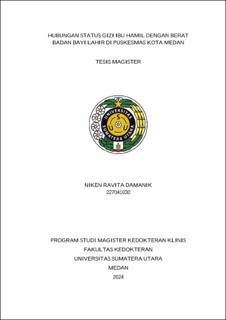Hubungan Status Gizi Ibu Hamil dengan Berat Badan Bayi Lahir di Puskesmas Kota Medan
The Relationship between Nutritional Status of Pregnant Women and Birth Weight at Comunity Health Centers in Medan

Date
2024Author
Damanik, Niken Ravita
Advisor(s)
Raja, Sarma Nursani L
Rusda, Muhammad
Metadata
Show full item recordAbstract
Background: The nutritional status of pregnant women plays a crucial role in determining the birth weight of infants. Nutritional status during pregnancy can be assessed using upper arm circumference (UAC) and weight gain during pregnancy. This study aims to investigate the relationship between the nutritional status of pregnant women and infant birth weight at Community Health Centers in Medan.
Method: This is analytic retrospective study with cross-sectional design. The sample was obtained from medical record of pregnant women who underwent antenatal care (ANC) at Community Health Centers in Medan and gave birth between July and December 2023 with the inclusion criteria. Bivariate analysis was conducted using chi-square or Fisher exact tests to analyze the relationship between the nutritional status of pregnant women and infant birth weight.
Results: The majority of the sample were women aged 26-30 years (42.7%) with normal pre-pregnancy Body mass Index (BMI) (52%). Most pregnant women gained weight during pregnancy according to recommendation from Institute of Medicine of National Academy of Sciences (36.1%) with normal UAC (86.8%). Most infants were born with normal birth weight (92.7%), followed by low birth weight (6.3%) and macrosomia (1.0%). The bivariate analysis revealed no significant relationship between weight gain during pregnancy and infant birth weight (p=0.105). However, a significant relationship was found between UAC and infant birth weight (p=0.002).
Conclusion: There is a significant relationship between the nutritional status of pregnant women, as measured by UAC and infant birth weight. UAC can be used as an early indicator to assess the nutritional status of pregnant women and predict better pregnancy outcomes.
